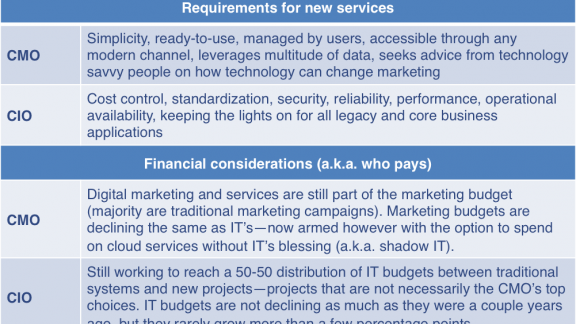AUTHOR: Enrico Boverino
Companies need to deploy a modern workplace and innovative infrastructure in order to digitize business processes, and that often calls for organizational and financial shifts in both the IT and marketing departments. Can a software-defined data center (SDDC)—which at first glance may appear to be purely a technology strategy—help CIOs and CMOs work together to deliver competitive business innovation while reducing budgets? I believe so.
A standard definition of digital services is difficult to nail down, but I found this one helpful: A digital service is one that has been entirely automated and which is controlled by the customer of the service. This describes a wide swath of new applications, personalized services, social interaction, and data analysis that might also include digital marketing initiatives. In this context, CIOs are now expected to show the business results of technology investments, and CMOs are also increasingly open to spending budgets outside traditional marketing in order to reach new users.
Different goals, complementary skills
In general, CMOs know about product placement, go to market, and new customer demands; they also have to protect the business from surprises like new competitors and disruptive business models. Increasingly, time is a precious commodity, as emphasis shifts to short product lifecycles to test new markets and services.
CIOs typically have a great understanding of corporate business processes, information security, and available resources. They are skilled at scouting new technology and solutions with a focus on expenditures and new areas of savings. It seems obvious that enabling greater coordination between these two worlds will lead to a more competitive, robust, and agile organization. But how?
It’s interesting to see how both goals and approaches of the two departments diverge in my engagements with customers— it tends to look like this:

Despite the best intentions to collaborate for mutual advantage and company-wide success, challenges quickly surface when we lay out each department’s specific objectives in an organizational matrix, especially when it comes to personal MBOs.
How can a software-defined data center help?
Having the ability to exploit a unified data center platform that provides new standards for automation, flexibility, and efficiency can bridge the different perspectives. In an SDDC, the compute, storage, networking, security, and availability services are pooled, aggregated, and delivered as intelligent, policy-driven software. Other key components include self-service, financial visibility, and policy-based provisioning for infrastructure and application. This provides business users with faster deployment and more reliable access to differentiating technology tools.
When CIO and CMO strategies are joined, it’s important to highlight the impacts an SDDC will have on efficiency (cost control), agility (revenue contribution), and reliability (quality of service and risk mitigation). The impacts of an SDDC adoption, together the priorities associated with the opportunities CMOs and CIOs are striving to take advantage of, will help to define and exploit personalized roadmaps.
When we consider impacts on agility, an SDDC implementation has three capabilities that can facilitate conversation between the CMO and CIO:
- Abstraction of applications from the underlying infrastructure enables true self- and automated provisioning of services, overcoming manual steps and the wait time that exists when multiple siloed IT groups need to communicate.
- The policy-based automation of pre-configured applications can simplify the processes related to the rework, which are often required to change configurations, or distribution of systems geographically.
- Governance and brokerage of public cloud services from IaaS to SaaS, which can also provide agility-related benefits such as lower costs and time to market, but must be evaluated and in many cases integrated within existing processes.
Over the past two years, I have helped many customers gain visibility and insights into their current level of maturity using a software-defined reference framework. Capturing meaningful KPIs helps to build an executable roadmap that aligns with user demand and provides the ability to measure improvement over time.
For example, the impact on agility described earlier can be measured through metrics that include:
- Revenue generated by new services
- Customer satisfaction
- Percent of workload offloaded to hybrid clouds
- Percent of requests fulfilled via self-service and standard catalog
- Time to provision additional capacity
Using their results to determine action plans needed to improve these metrics, CMOs and CIOs can decide which capability to address first and which marketing/IT joint investments will lead to the most beneficial business outcomes within the shortest amount of time.
=========
Enrico Boverino is senior business solution strategist for VMware Accelerate Advisory Services based in Italy. You can follow him on Twitter at @eboverino.
[1] Lea-Cox and Associates: “Business Services vs IT Services vs Digital Services”




